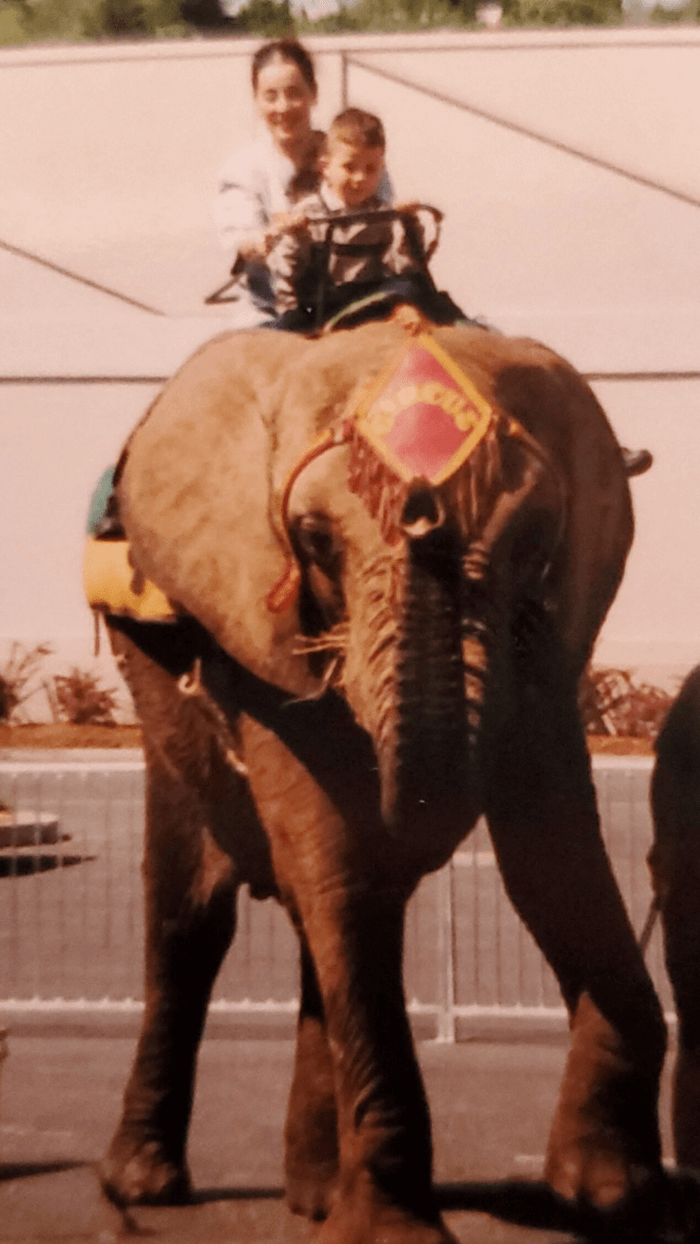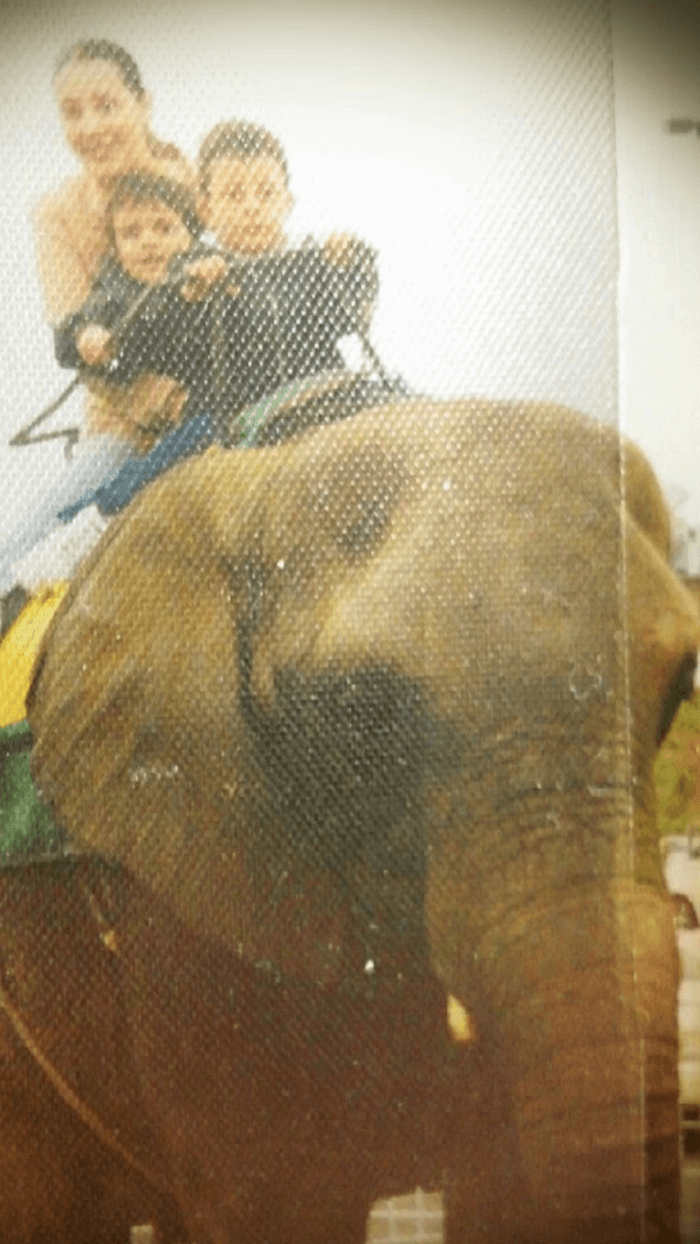Karen was a wild-born elephant imprisoned for decades along with elephants Beulah and Minnie in a Connecticut-based traveling circus called the Commerford Zoo. She was the NhRP’s client in our Connecticut elephant rights litigation until she died in March of 2019. Jordon Adorno is an NhRP supporter and Connecticut resident who generously shared with us the highly personal story below to honor Karen one year after her passing.
The year was 1997. I was two years old. My parents brought me and my two younger brothers to a carnival in Waterbury, Connecticut that included a petting zoo put on by the Commerford Zoo.
The event was huge. Everywhere I looked, there were rides, games, prizes, and food. But what drew my attention the most was an elephant. Elephants were already my favorite animal, so the moment I saw her became a moment I’d never forget.
As I’d later learn, her name was Karen. Every year for over a decade, my parents took me to see her when the Commerford Zoo came to town. [Editor’s note from the NhRP: For decades, the Commerford Zoo transported Beulah, Karen, and Minnie to work at circuses, fairs, and other events across the Northeast.]

Like the other parents, my mom and dad would pay for my brothers and me to ride Karen. I always felt safe and happy going on her back. “This is my girl Karen,” I’d yell to the crowd. Afterwards, with my parents watching closely, I’d go behind the barriers and call out her name. She’d come straight to me, sniff me with her trunk, and wrap her trunk around my waist, while everyone in the crowd around me shrank back in fear. I’d hug her and sometimes sneak in candy or peanuts for her to munch on. On several occasions, I’d find her tied up behind the Commerford Zoo’s trucks. I’d play hide-and-seek with Karen, and with her eyes she’d follow my every movement. Eventually, the Commerford Zoo stopped charging us to ride her because they recognized us, especially me. [Fortunately, Jordon never personally felt threatened by Karen. However, the Commerford Zoo, in having allowed Karen to interact with Jordon, put his and her safety at great risk. Click here to read more about the Commerford Zoo’s many violations of the Animal Welfare Act, including for failing to have an employee or attendant present during periods of public contact with the elephants and failing to keep the elephants under the control of a handler while they were giving rides. – NhRP]

When my parents first started taking me to the petting zoo, they were very young. As they got older, they tried telling me they felt like something was very wrong with how the Commerford Zoo was treating Karen, but for a long time, my happiness in seeing Karen, and my desire not to hear or believe she was suffering, blinded me to the realities of her life. At the same time, even when I was little, I hoped for something better for her, telling my family and friends that when I grew up and had enough money, I’d buy a big chunk of land and build Karen a place to live.
Every year for over a decade, I went to see her. When I was 15 years old, the Commerford Zoo stopped coming to the carnival, but I never stopped wondering and worrying about how Karen was. When the Commerford Zoo returned to Waterbury two years later, my mom and I drove to the parking lot of the venue, where I saw an elephant who I knew wasn’t Karen. [The elephant Jordon saw that day was either Beulah, who collapsed and died at the Big E fair in 2019, or Minnie, who is the sole surviving Commerford Zoo elephant. – NhRP]. It was at that moment that I finally saw what my parents saw: the bullhooks, the endless labor, the horrible unnaturalness of an elephant giving rides in a parking lot when she should have been roaming in the wild with her family. [Beulah, Karen, and Minnie were all torn from their herds and natural habitats when they were young and imported to the US. – NhRP].
Five years later, after I had lost hope of ever seeing Karen again, I saw my cousin had posted Snapchat photos of her with several animals at the XL Center. I immediately called her and asked her to find an elephant named Karen. “How the hell am I going to find an elephant, Jordon?” she asked. “Trust me,” I said, “you won’t be able to miss her.”
Five minutes later, I received a photo. IT WAS KAREN! I ran outside and banged on my mom’s truck to get her attention before she left for work. I almost gave my mom a heart attack, but she was just as excited as I was by the possibility of seeing how Karen was doing.
We went to the XL Center the next day. I ran straight into the building, got our tickets, and ran from employee to employee, asking where Karen was. They all pointed in the same direction.
Even from a distance I knew it was her. But the closer I got, the more I could see her suffering. It was like looking at a totally different elephant than the one I remembered from childhood. She was staring at the ground and swaying back and forth. [Elephants sway and engage in other repetitive behaviors when under psychological stress. – NhRP]. I called out her name, hoping she’d remember my voice. She looked up immediately and attempted to stick out her trunk out as I extended my hand to her. It was at that moment that a Commerford Zoo employee stabbed her with a bullhook.
Karen was clearly in pain and afraid of the sharp instrument. I was horrified, and so was my mom, who came up behind me and placed her hand on my shoulder. We both knew Karen was suffering and that there wasn’t anything we could do about it. I stood there with my mom for a long time until my dad found us and told us he was ready to leave. One final time, I looked at Karen and reached out to touch her trunk, which she wrapped around my arm (in the countless hours I spent with Karen, I never saw her interact that way with anyone other than me). I told her I loved her. As I walked away, I heard a loud rumble. I turned and saw Karen lifting up her trunk as if to say goodbye. I thought I could see tears in her eyes. I felt then just how enormously she had suffered both physically and mentally over the years. [Visit ElephantVoices to learn about how elephants suffer in circuses. – NhRP].
In the years after that moment, out of concern for Karen, I’d look for her at the carnival and ask the Commerford Zoo employees where she was and how she was doing. At that point, the Commerford Zoo began refusing to answer my questions, I think so that they wouldn’t have to listen to another “uneducated individual” tell them how to take care of “their” animals. In my opinion, they should have listened to all the people who I’ve since learned were as worried about the elephants as my family was.
A year ago, Karen died. The Commerford Zoo didn’t make her death public until Beulah also died and a TV station called them up to ask about Karen after the NhRP raised concerns about her whereabouts and well-being. When I found out Karen was gone, I was devastated. Still to this day when I think of her I get very upset, knowing how hard her life was and how she was taken from her family and forced to give rides all her life. At the same time, I grieve the years-long bond we had while she was alive and think often about the extraordinary compassion elephants show to one another and other species and wish we showed more compassion to them.
As a child, I was one of the people who rode her without realizing the harm it causes elephants to carry people on their backs and be controlled by a bullhook. As I matured, I saw Karen’s pain, and through the media coverage of Beulah and Karen’s deaths, I learned of the NhRP’s fight to free Minnie to a sanctuary out of respect for her right to liberty. I fully support Minnie’s release to the Performing Animal Welfare Society or The Elephant Sanctuary in Tennessee, where she can have the safe space I dreamed of building for Karen when I was a little boy. I think Karen would want that for Minnie:
https://www.instagram.com/p/B3XuPBph2KD/
Like all elephants, Minnie belongs in a place where there are no chains, no one forcing them to work, and especially NO BULLHOOKS. I hope this story will help other people who love elephants see what my family members and I came to see: that elephants need to be free.
With assistance from U.S. Senator Richard Blumenthal (D-CT), the NhRP confirmed that Beulah collapsed and died in September of 2019 at the Big E fair as a result of blood poisoning caused by a uterine infection the Commerford Zoo was aware she had when they forced her to travel in a trailer from Connecticut to Massachusetts to be exhibited for their financial gain. Karen died of kidney disease at 38 years old. Beulah and Karen were both receiving what the USDA considers “appropriate care” at the time of their deaths. While much remains unknown about how long Karen had been sick, or if she was suffering from other ailments when she died, we know she died at a much earlier age than elephants typically do. We also know “appropriate care” is meaningless if you remain a prisoner subjected to forced labor. To learn more our Connecticut elephant rights litigation, visit Beulah, Karen, and Minnie’s court case timeline. To learn how you can help, visit their grassroots advocacy campaign page, and share this story via social media with the hashtags #FreeMinnie and/or #RumbleForRights.